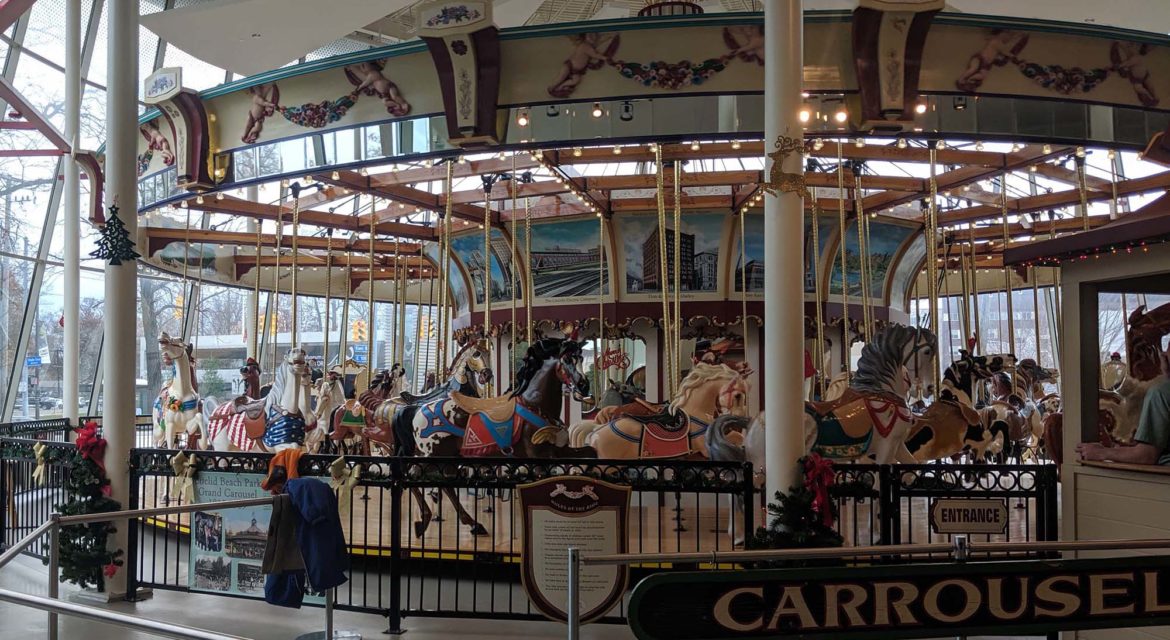 Numerous monuments have been created on account of efforts that celebrate the history of a space or enable entirely new experiences for audiences. The Grand Carousel from Euclid Beach Park that is on display in the Cleveland History Museum showcases the incredible history of that park while also allowing visitors to take a ride on the Carousel itself. In doing so it has become a monument that bridges the past to the present for the benefit of everyone.
Numerous monuments have been created on account of efforts that celebrate the history of a space or enable entirely new experiences for audiences. The Grand Carousel from Euclid Beach Park that is on display in the Cleveland History Museum showcases the incredible history of that park while also allowing visitors to take a ride on the Carousel itself. In doing so it has become a monument that bridges the past to the present for the benefit of everyone.

An Amusement Park on the Southern Shore of Lake Erie
 Fully detailed in the book “Euclid Beach Park”, a small tract of land on the southern shore of Lake Erie, on the east side of Cleveland, was transformed into an amusement park for the enjoyment of the entire region. Euclid Beach Park opened on June 22, 1895 and would eventually become an institution of the community. During its most prosperous years the park offered a vast array of major rides and attractions and also utilized industry innovations in ride design, construction, and park management.
Fully detailed in the book “Euclid Beach Park”, a small tract of land on the southern shore of Lake Erie, on the east side of Cleveland, was transformed into an amusement park for the enjoyment of the entire region. Euclid Beach Park opened on June 22, 1895 and would eventually become an institution of the community. During its most prosperous years the park offered a vast array of major rides and attractions and also utilized industry innovations in ride design, construction, and park management.
By the 1960s, the Euclid Beach Park was beginning to face financial and attendance issues. Rides were sold to reduce operating costs but they weren’t enough to save the park. Euclid Beach Park closed on September 28, 1969, after 74 seasons and most of the assets were sold off, while the remaining infrastructure was eventually lost in a fire. At the original site, a few signs of the park remain, including the shuffleboard area, remnants of the beachside fountain and concrete footers of the Flying Turns roller coaster.
The Grand Carousel was installed at Euclid Beach Park in 1910. When the park was closed in 1969, the carousel was sold to another park that that same year. After being moved out of state and changing ownership a few times, the carousel was purchased and put under the stewardship of the Western Reserve Historical Society (WRHS) in 1998. Restoration of all the horses and the chariots was begun and the carousel was reopened in 2014 at the Cleveland History Center of the Western Reserve Historical Society.
Much of this history has been preserved and is on display at the Cleveland History Museum, where visitors can not only learn about this history but also ride on the Grand Carousel itself.

Creating Experiences, Preserving History and Enabling Economic Opportunities
 The Cleveland History Museum is designed to tell the story of Northeast Ohio through the use of its vast collections and give the public a sense of place in today’s mobile society. Each document and artifact tells a story that personally engages individuals but few are able to convey this sense of history and place better than that Grand Carousel.
The Cleveland History Museum is designed to tell the story of Northeast Ohio through the use of its vast collections and give the public a sense of place in today’s mobile society. Each document and artifact tells a story that personally engages individuals but few are able to convey this sense of history and place better than that Grand Carousel.
Guests can enjoy a ride on many of the original horses and see hand-painted scenes depicting Cleveland icons and Euclid Beach Park. The colorful, hand-carved wooden horses provide visitors with an experience that audiences have been having for decades. Efforts to save and preserve the Grand Carousel have seen the creation of numerous sponsorships and dedications that appear all around the carousel.
This history is something visitors can directly support in the gift shop, where various items associated with the Grand Carousel and Euclid Beach Park are available for purchase. The space is also available to rent for corporate events, client entertainment, holiday parties, birthday parties, weddings and more.
By preserving and embracing the legacy of Euclid Beach Park, the Cleveland History Museum has enabled the Grand Carousel to become much more than a ride. It has become a monument that continues to attract and create experiences for audiences in the present while preserving an essential piece of history for the future.

Preserving and Celebrating the Legacy of Euclid Beach Park
 Carousels have come to serve as attractions for various cities, but few contain the kind of history that the Grand Carousel from Euclid Beach Park showcases. It highlights how sites of all kinds can protect and embrace a legacy that otherwise might be lost in order to draw in audiences from all areas and eras.
Carousels have come to serve as attractions for various cities, but few contain the kind of history that the Grand Carousel from Euclid Beach Park showcases. It highlights how sites of all kinds can protect and embrace a legacy that otherwise might be lost in order to draw in audiences from all areas and eras.

